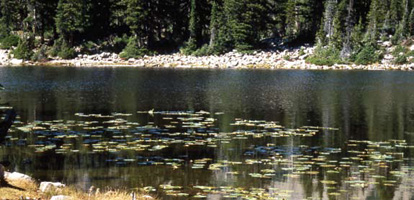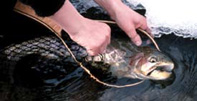Still Water Dead Drift

Simply cast to the desired target area and strip in the excess slack line; carefully watch the fly. Some animation is helpful and is furnished by a “sudden inch” struggling movement. One or two quick hand twist retrieves can cause the fly to suddenly move

several inches and animate the fly’s hackles by disturbing the surface film; furthermore, this action draws attention to the fly. An intermittent longer movement of about six inches followed by a pause is productive. To avoid unnatural motions keep in direct contact with the fly by allowing only a slight amount of slack line.
During windy times an intermediate sink rate line is more useful; it settles just below the surface and is not blown around as much as a floating line.
When cruising fish are present, notice their direction of travel and the cast is made to anticipate their next feeding site. This is perplexing because the fish move in irregular patterns rather than in straight lines. Envision the feeding pattern and rhythm. Estimate the next rise location by extrapolating from past rises. Once the cast is made, animate the fly a little to draw attention. Then stop and watch for the rise.


© 2025 The Gale Group, Inc. All rights reserved.
© 2025 Perigee Learning LLC. All rights reserved.
LoveTheOutdoors.com is owned and operated by Advameg, Inc. © 2025 Advameg, Inc.
Camping Adventures • Dutch Oven Cooking • Sports Knots
Fly Tying • Freshwater Fishing • Fly Fishing

